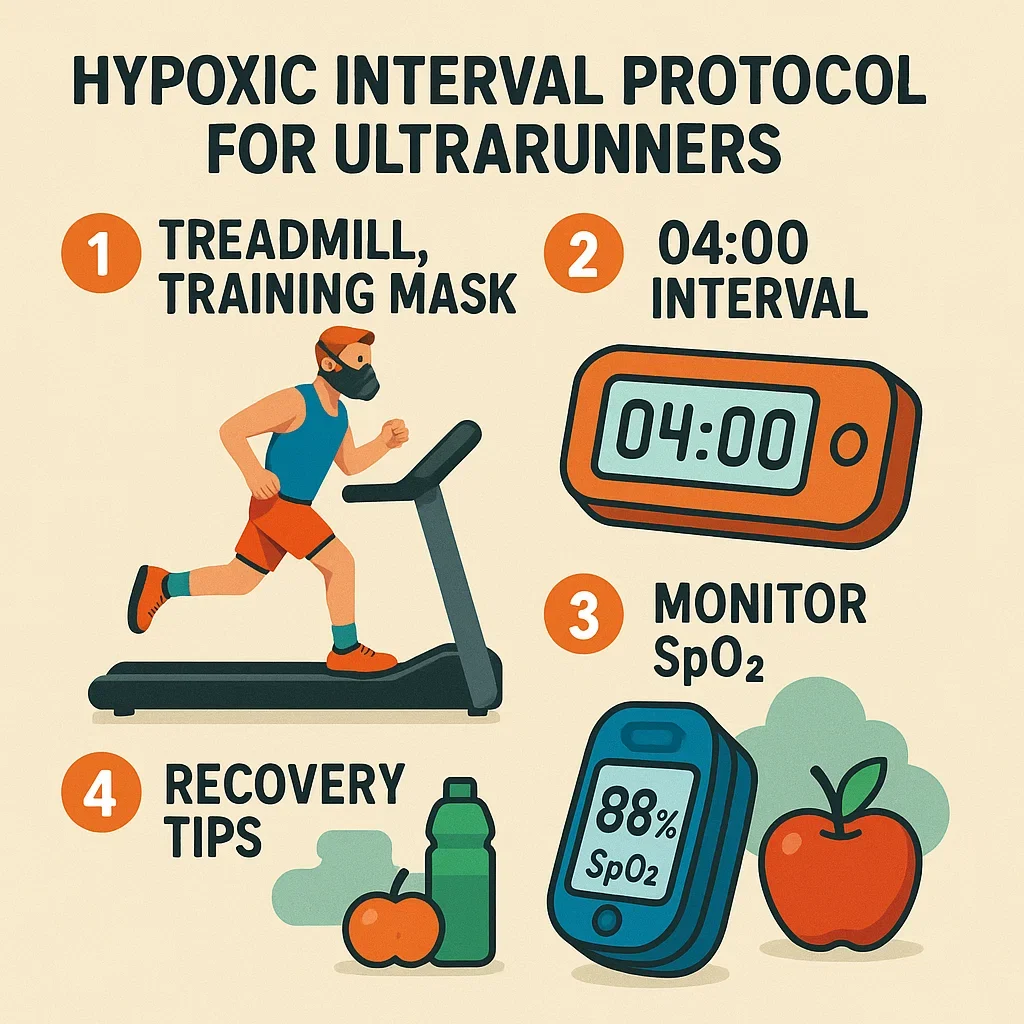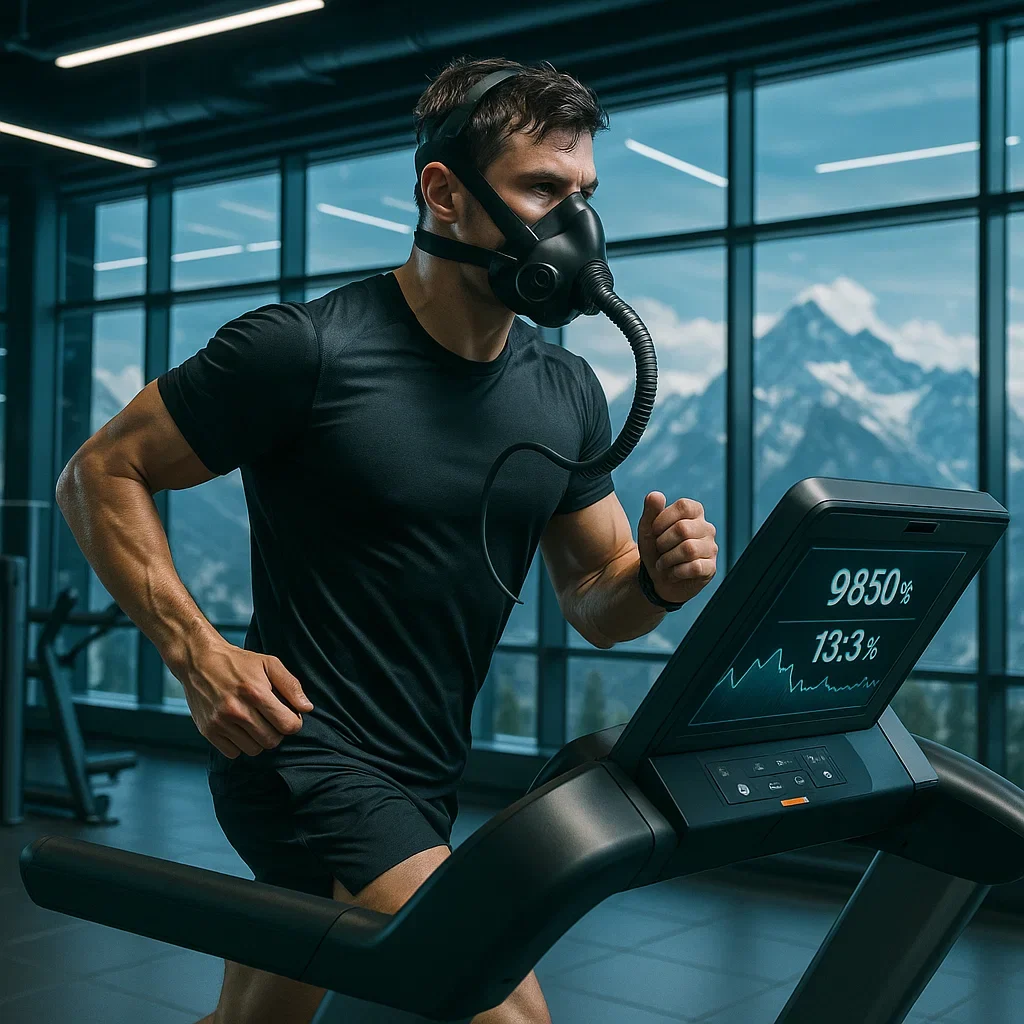Hypoxic Treadmill Workouts for Ultramarathoners: Protocols, Science & Adaptation
Want to build mountain lungs—even if your city’s at sea level? Welcome to hypoxic treadmill workouts—the smart, scientific way to bring the effects of altitude into your daily training routine. No tent, no travel, just focused intervals that teach your body to perform on less oxygen. Here’s how it works, why it matters, and how to use it safely for real-world ultramarathon gains.
🧬 What Is Hypoxic Treadmill Training?
Hypoxic treadmill training means running (or hiking) on a treadmill while breathing air with reduced oxygen—usually via a special mask and hypoxic generator, or in a low-O₂ room/lab. The aim? To simulate the stress of altitude, forcing your body to adapt with better O₂ delivery, greater fatigue resistance, and faster recovery at elevation.
- Simulated altitude: Most protocols set FiO₂ (fraction of inspired oxygen) to 15–17%—equal to 2,000–3,000 meters.
- Short, focused sessions: You “train high” for intervals (not hours), maximizing stimulus while controlling recovery.
- Used by the pros: Many national teams, elite mountain runners, and even soccer clubs now use hypoxic workouts for edge and adaptation.
🔬 The Science: How Does Hypoxic Training Help Runners?
- Boosts red blood cell count: Repeated low-O₂ intervals stimulate erythropoietin (EPO) and red cell production, especially if your iron is adequate.
- Improves muscle efficiency: Your muscles get better at extracting oxygen and tolerating lactate, for longer climbs and harder efforts.
- Enhances ventilation: You learn to breathe deeper and faster under stress—key for thin air races.
- Raises altitude threshold: The point where you start to slow down or get symptoms moves higher—more meters, more miles!
- Science-backed: Dozens of studies show measurable improvements in VO₂max, SpO₂, and race performance after hypoxic intervals—even in recreational athletes.
🏃♂️ Best Protocols: Hypoxic Intervals for Ultramarathoners
Here are practical, science-tested hypoxic treadmill protocols for trail and ultra athletes. Always individualize based on fitness, race goals, and recovery.
-
Classic Hypoxic Intervals (2x/week, 4–6 weeks):
- 5–8 × 3 min at 85–95% race effort (simulate uphill grade), hypoxic mask ON
- 3 min easy jog or walk (mask OFF or FiO₂ ↑) between intervals
- Warm-up and cool down at normal oxygen (10–20 min each)
-
Longer Threshold Session (1x/week, 3–4 weeks):
- 2–3 × 8–12 min at steady “tempo” pace, hypoxic mask ON
- 6–8 min easy recovery, mask OFF
- Monitor heart rate and RPE (rate of perceived exertion)
-
“Climb Simulation” Block:
- 30–40 min treadmill hike/run at 8–15% incline, mask ON, at lower intensity
- Focus on upright posture, deep breathing, relaxed hands
🩸 Iron, Recovery & SpO₂ Monitoring
- Iron stores: Ferritin must be >40–50 ng/mL to get red blood cell gains. Blood test before starting any hypoxic protocol!
- SpO₂ checks: Use a fingertip pulse oximeter before/after each session. Values under 88% during intervals = slow down or take longer recoveries.
- Prioritize recovery: Hydrate, eat extra carbs, sleep well. Hypoxic intervals are a big stress—don’t pile on extra hard training!
💡 Practical Tips for Success
- Track every session: Log SpO₂, HR, RPE, interval count, and total time. You’ll spot trends—and early warning signs of overdoing it.
- Hydrate more: Hypoxic training increases fluid needs. Add electrolytes if sweating heavily.
- Fuel up: Eat a carb-rich snack within 30 minutes after intervals—glycogen and iron absorption both matter for adaptation.
- Rotate workouts: Alternate hypoxic and regular interval days to avoid deep fatigue.
- Rest when needed: If performance or mood dips for 2–3 days, take extra recovery. Adaptation happens outside the gym!
- Quality over quantity: Two high-quality sessions per week often outperform four “meh” ones. More is NOT always better.
⚠️ Safety: Who Should Avoid Hypoxic Training?
- Anyone with untreated anemia (low ferritin, low hemoglobin)
- People with heart or serious lung conditions
- Those recovering from infection, illness, or deep fatigue
- Pregnant runners (unless cleared by a doctor)
- Anyone who cannot tolerate even mild shortness of breath—comfort matters
❓ Frequently Asked Questions (FAQ)
😮💨 Does hypoxic treadmill training really help for high-altitude ultras?
⏲️ How long should a hypoxic interval session last?
🗓️ How many sessions per week is best?
🩸 Is iron supplementation needed for everyone?
⚠️ What are warning signs to stop a session?
👟 Can I simulate hills or mountain trails?
🔬 Is the adaptation permanent?
🧠 Can hypoxic training improve mental toughness?
📱 Should I track my SpO₂ every session?
🌍 Is this only for elites or mountain runners?
🏁 Summary & Lost Pace Final Thoughts
Hypoxic treadmill workouts are your ticket to mountain-level adaptation—without ever leaving your city. When built on a foundation of good iron status, smart protocols, and recovery, these sessions can help you climb higher, run longer, and race stronger at any altitude.
Remember: adaptation is a journey, not a hack. Embrace the process, trust your body, and enjoy the gains—both on the treadmill and on the trails.


About the Author
Lost Pace is an ultramarathon runner, shoe-tester and the founder of umit.net. Based year-round in Türkiye’s rugged Kaçkar Mountains, he has logged 10,000 + km of technical trail running and completed multiple 50 K–100 K ultras.
Blending mountain grit with data, Lost analyses power (CP 300 W), HRV and nutrition to craft evidence-backed training plans. He has co-written 260 + long-form guides on footwear science, recovery and endurance nutrition, and is a regular beta-tester of AI-driven coaching tools.
When he isn’t chasing PRs or testing midsoles, you’ll find him sharing peer-reviewed research in plain English to help runners train smarter, stay healthier and finish stronger.
Ultrarunner · Data geek · Vegan athlete

